Sun Apr 16 – Mon Apr 17
We had just one day in London before heading to Canterbury where we will begin our long walk. There is so much to see in London that it was difficult to know what to choose. We clearly weren’t going to be able to do too much. We decided to do the Open-Top Bus tour which wold give us a glimpse of many things, and to get off the bus at Tower Bridge to do a tour there & then visit the nearby Tower of London.
 The Churchill Arms Pub built in 1750 & frequently visited by Winston Churchill’s grandparents in the 1800s which eventually led to its name after WWII
The Churchill Arms Pub built in 1750 & frequently visited by Winston Churchill’s grandparents in the 1800s which eventually led to its name after WWII
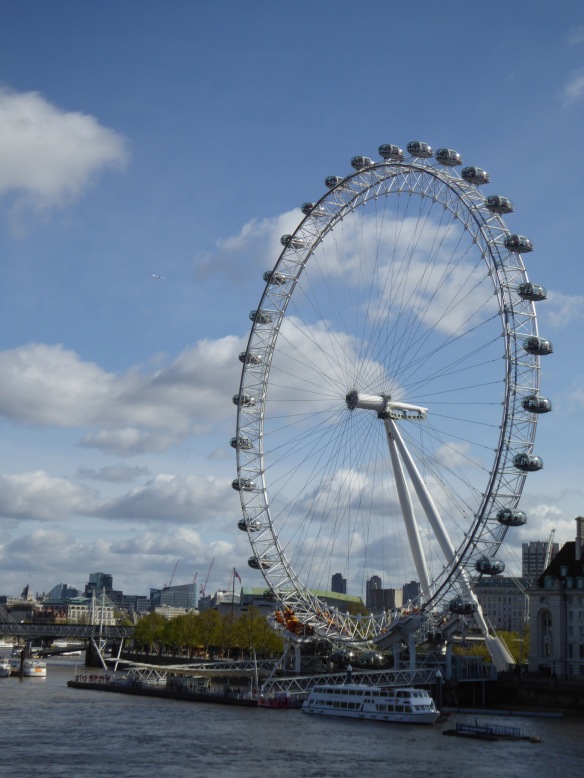 Opened in 2000, the London Eye, the world’s largest cantilevered observation wheel, 135 metres, beside the River Thames
Opened in 2000, the London Eye, the world’s largest cantilevered observation wheel, 135 metres, beside the River Thames
The morning was fine with scattered clouds but it was very cold, especially considering that it’s mid-spring. I wore a wool singlet, shirt, wool thermal & two fleeces. On the open bus I added a raincoat, scarf & beanie to try to keep out the cold but to no avail. After about two hours (it was a long ride) when we arrived at Tower Bridge we were both freezing, Pete even more than me because he had a bit less on than I did. We went to a nearby pub for a coffee to warm us up & for an early lunch. It was so good to thaw out!
We steeled ourselves for the cold again & ventured back outside to make our way to Tower Bridge. What a beautiful, elegant structure it is. It was built between 1886 & 1894. The high level crossings were originally designed as walkways so that the public could still cross the Thames while the bridge was open. This function was ceased in 1910 due to lack of use.
Today those walkways get a great deal of use because they are a key area of the tour of the bridge for tourists. As well as providing wonderful views along the river, they house a display & information about other interesting bridges throughout the world. Best of all they are enclosed by glass so it was nice & warm.
 A turret seen through the structure of the upper walkway
A turret seen through the structure of the upper walkway
 There were glass panels in the floor allowing visitors to look down on the road & river below
There were glass panels in the floor allowing visitors to look down on the road & river below
 London’s Town Hall (the rounded building) & ‘The Shard’, tallest building in the United Kingdom, viewed from the bridge
London’s Town Hall (the rounded building) & ‘The Shard’, tallest building in the United Kingdom, viewed from the bridge
 Moses Bridge uniquely crosses a 17th century moat in the Netherlands by dividing the water rather than crossing above it
Moses Bridge uniquely crosses a 17th century moat in the Netherlands by dividing the water rather than crossing above it
The old engine room which powered the mechanism responsible for raising & lowering the bridge was also open with an interesting, well explained exhibition with machinery that has been so beautifully preserved that they almost looked new. The bridge was opened & closed using steam driven engines that raised & lowered counterweights which operated the mechanism. Now, it’s controlled electrically.
 Restored machinery in the engine room
Restored machinery in the engine room
 One of the counterweights raised & lowered to open & close the bridge
One of the counterweights raised & lowered to open & close the bridge
Having seen the bridge we recrossed to the north side of the river to visit the Tower of London which was founded towards the end of 1066 as part of the Norman conquest of England. It’s a much bigger complex than I had imagined & it is the central tower, the White Tower, the oldest structure, that gives the complex it’s name. It has been used as a fortress, a prison, a grand palace, an armoury, the treasury, a menagerie, a public record office & the home of the Crown Jewels of England – quite a variety!
 Panorama of the Tower of London
Panorama of the Tower of London
 There were numerous animals made largely of wire netting reminiscent of when the Tower was a menagerie
There were numerous animals made largely of wire netting reminiscent of when the Tower was a menagerie
Just inside the entrance was the old mint display where we learnt about the old coins, how the mint workers used to dilute the quality of the gold & silver to steal for themselves & about the measures taken to stop them.
A walk around the battlements gave some lovely views back to the bridge & in every bastion there was some kind of display. After a once around we decided to join the long queue for a look at the Crown Jewels. It took us half an hour to reach the display but we didn’t think that we could come so close without making the effort to see them. The collection includes not just crowns, but other items used in ceremonial life as well. There are some amazing jewels in the collection, the most famous of which is probably the 530.2 carat Cullinan I diamond, the Great Star of Africa, in the Sovereign’s Sceptre. It is the largest colourless cut diamond in the world. The crown of the Queen Mother, although not adorned with any famous diamonds, is set with 2,800 diamonds so it really sparkles.
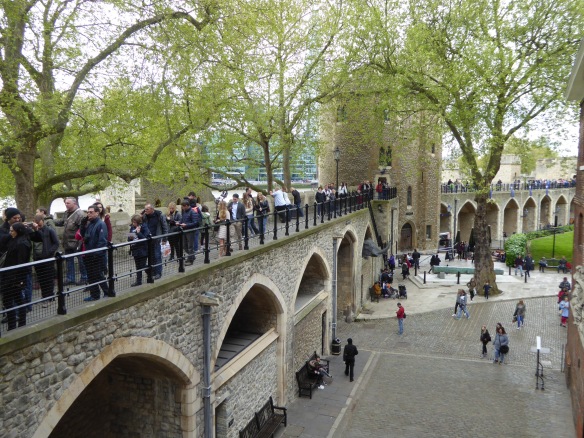 Walking around the battlements
Walking around the battlements
We finished our tour by visiting the Royal Armoury housed in the central White Tower, so called because it was traditionally whitewashed since 1240 in the reign of Henry III. The whitewashing was stopped 400 years later after the Great Fire when Christopher Wren was tasked with rebuilding much of London. He didn’t like the whitewashing & ordered it stopped & it’s never been painted since then. The Armoury has been housed there since the late 1400s when armour was both made & stored there.
There are quite a few suits of armour mounted on horseback. They are part of a 400-year-old exhibition. The Kings of England were displayed on beautifully carved wooden horses. We were told that the magnificent white horse which Henry VIII rode got a bad case of woodworm & had to be ‘put down’. Henry now stands & has a large grey wooden horse, part of one of the biggest collection of 17th century wooden horses anywhere. It is an impressive display although only a small portion of the collection is shown at any one time.
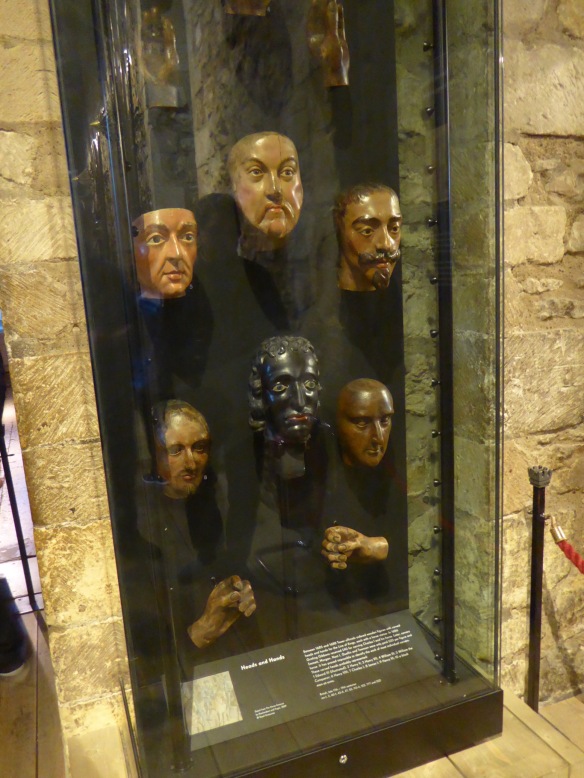 Wooden carved heads & hands of kings to be placed in the suits of armour in the ‘Line of Kings’ display
Wooden carved heads & hands of kings to be placed in the suits of armour in the ‘Line of Kings’ display
 One of the Kings mounted on a magnificent wooden steed
One of the Kings mounted on a magnificent wooden steed
By the time we finished there we were fairly well exhausted so we rejoined the open top bus for the remainder of the route. As well as being very cold it tried to rain on us a couple of times. Fortunately it didn’t rain enough to really wet us. It had been a very good day which we topped off with a very ordinary Italian dinner served with veggies cooked well beyond anything a self-respecting Italian would be satisfied with.
 Big Ben, the world’s most famous clock
Big Ben, the world’s most famous clock
After only about 3 hours sleep for me – I haven’t adjusted to local time yet – we were up and away by 6.30 to catch the train & bus to Canterbury. The clear air was very cold (predicted 2° to 11° today). We arrived in Canterbury, had coffee then went to drop our backpacks at our Airbnb host’s place. Vivien had kindly allowed us to drop them there even though check-in was not till 2 pm.
Canterbury is a lovely old town. The centre is pedestrianised so it was great to wander unimpeded through the narrow streets. Our first stop was Canterbury Cathedral because it was the most important thing for us. As we were commencing our walk the next day we needed to get our ‘Pilgrim Passports’ stamped. We asked at the gate where tourists have to pay to get in, & to our surprise, we were allowed in free because we are pilgrims. We spent about 2 hours exploring the massive cathedral & its grounds. My one disappointment was that we could find no mention of Sigeric, the archbishop whose documented journey has provided today’s route for the Via Francigena, other than in a list of all the Archbishops. We asked one priest & two guides about him & were surprised to find that we knew more about him than any of them did.
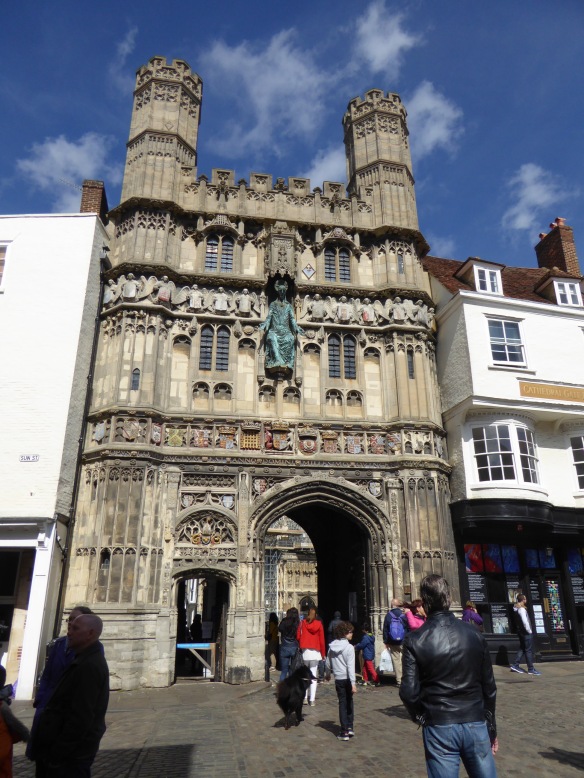 Entry gate to Canterbury Cathedral
Entry gate to Canterbury Cathedral
Founded in 597, the cathedral is one of the oldest Christian structures in England but it was completely rebuilt from 1070 to 1077 & has been modified & added to several times since then. Luckily it survived several bombings of the town during WWII (one of the guides said that the Germans would leave the churches because they helped them to identify the towns) but lost quite a lot of its old stained glass windows when the cathedral library, adjacent to the cathedral, was destroyed by a bomb. There is a lot of restoration work going on both outside & inside so there was plenty of scaffolding but it didn’t really detract from the overall grandeur of the building.
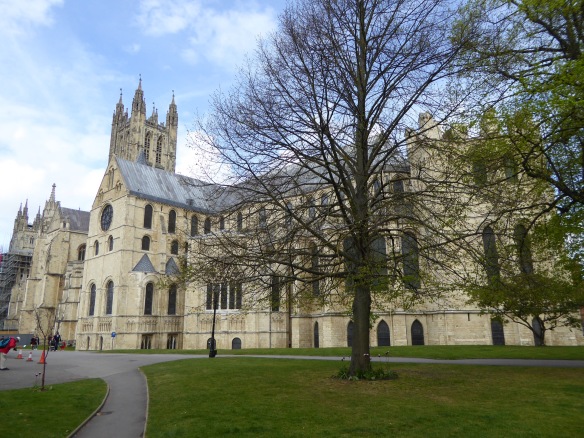 Canterbury Cathedral from the apse end
Canterbury Cathedral from the apse end
 Much of the front of the cathedral is hidden at the moment
Much of the front of the cathedral is hidden at the moment
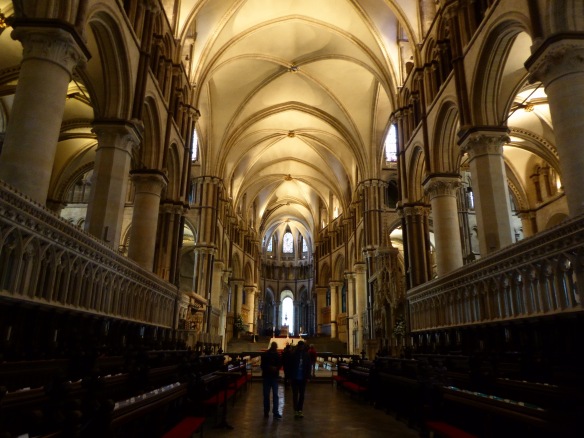 Small portion of the length of the cathedral
Small portion of the length of the cathedral
 Detail on the Hales Memorial for James Hales, treasurer of the Portuguese Expedition in 1589 who died & was buried at sea
Detail on the Hales Memorial for James Hales, treasurer of the Portuguese Expedition in 1589 who died & was buried at sea
 Henry VIII resplendent in stained glass & Abbot Cranmer, architect
Henry VIII resplendent in stained glass & Abbot Cranmer, architect
 Ceiling of the colonnade in the cloister decorated with miniature shields
Ceiling of the colonnade in the cloister decorated with miniature shields
When we’d finished there & had some lunch we walked the old streets then went to find a few more of the sights. The Westgate Towers have stood over the road to London for 6 centuries & are England’s oldest surviving Medieval Gateway. The ruins of the Norman Castle looked interesting but we couldn’t get into them, we just got the view from outside the fence.
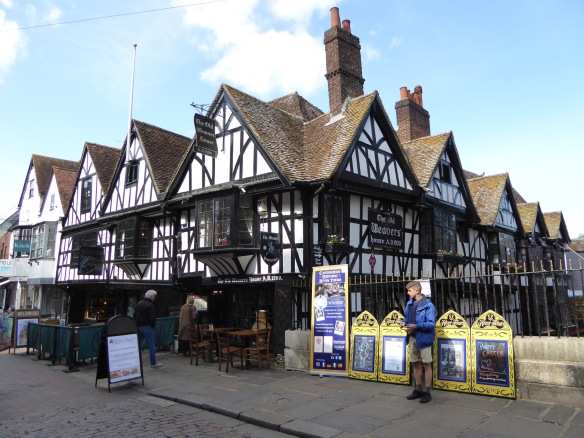 Tudor houses in the centre of town
Tudor houses in the centre of town
 Canterbury’s most famous resident, Geoffrey Chaucer
Canterbury’s most famous resident, Geoffrey Chaucer
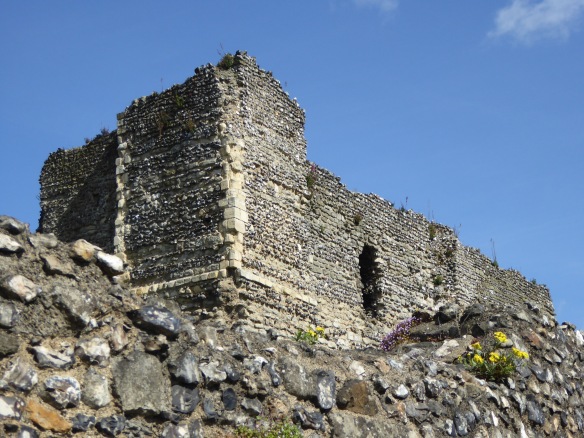 Ruins of the Norman Castle seen above its surrounding wall
Ruins of the Norman Castle seen above its surrounding wall
From there we headed for home but stopped at St Augustine’s Abbey on the way. It was founded in 597. It fell into disrepair in the 16th century after Henry VIII dissolved all Catholic monasteries. Now only ruins are left. Our last stop was St Martin’s Church, founded in the 6th century, it is claimed to be the oldest church in the English-speaking world.
In the evening we’d organised to meet a fellow that Pete ‘knows’ through his hobby of helping people with Excel spreadsheets on an Internet forum called MrExcel. We met Derek & his wife Steph for drinks after dinner & spent a really enjoyable hour & a half chatting with them. That brought our evening to a close. It had been another wonderful but cold day.

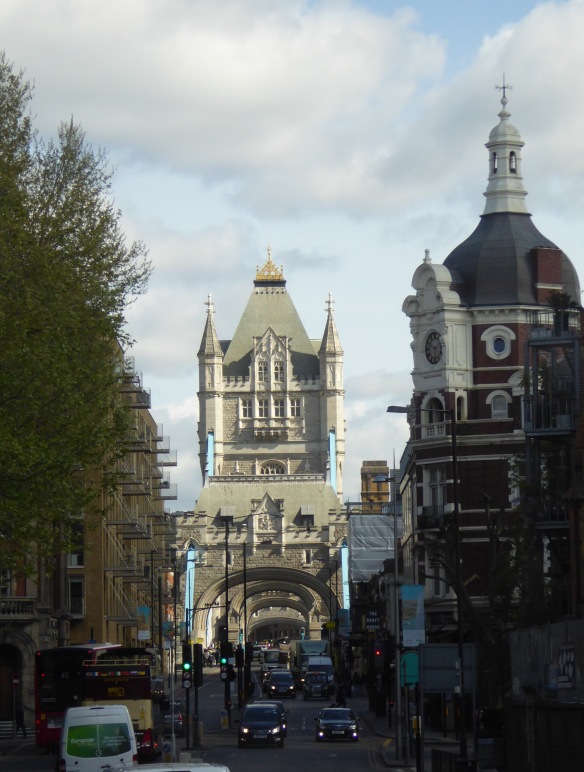







This made for great reading, and I love the photos – but I don’t want to hear about the cold! I fly to London tomorrow to spend the weekend with my aunt in Hertfordshire, and I’m not keen to leave the warmth of Mallorca! It is NEVER warm in London – at least, never when we are there, whatever the season. I hope the weather gets better for you, so that you don’t have to wear layers and layers every day. Looking forward to the next instalment – thank you for taking so much time with your blog.
LikeLike
Sandra, we hope that your trip to England is warm – but not sure that is going to happen for you. My weather app says a little warmer than when we were there but I’m not sure that you would regard maximums of less than 20°C as ‘toasty’.
We have just arrived in France & the temperature is inching up. Jen has shed one of those layers, so now must be down to only about five. 😄
Glad you enjoyed the post – doing the blog is a pleasure for Jen. Despite my goading, she is always a bit behind with her posts though.
LikeLike
Buongiorno,, brilliant detailed commentary, loved it, beautiful old buildings, still warm in Kempsey, enjoy, thanks
LikeLike
Cheers Steve. Oh for some of that Kempsey warmth at the moment.
Peter
LikeLike
A really interesting post Mum – all the history is so interesting! I don’t think I would have survived that cold, but you saw quite a lot for just your one day in London. I liked the glass floors in the bridge, and the picture of the Moses bridge – too bad you couldn’t visit that bridge in reality! Looking forward to seeing the journey of your walk. (PS: your raincoats arrived this week… hope the ones you’ve got do the job and that you don’t miss these ones!)
LikeLike
Hi Kate,
You would have brought more clothes than us so would have rugged up & been fine.
Thanks for letting us know about the raincoats but we’ll just have to survive with what we have. So far we have been lucky with (almost no) rain. Fingers crossed it stays that way at least until the weather warms up a bit more.
We are still waiting for a day when the temperature starts with a ‘2’. We have actually already had such a temperature – the problem was that it only contained that one digit!! 😬
Dad
LikeLike